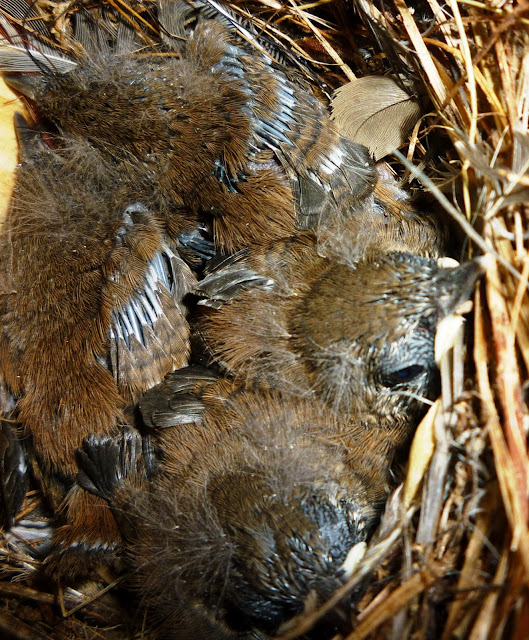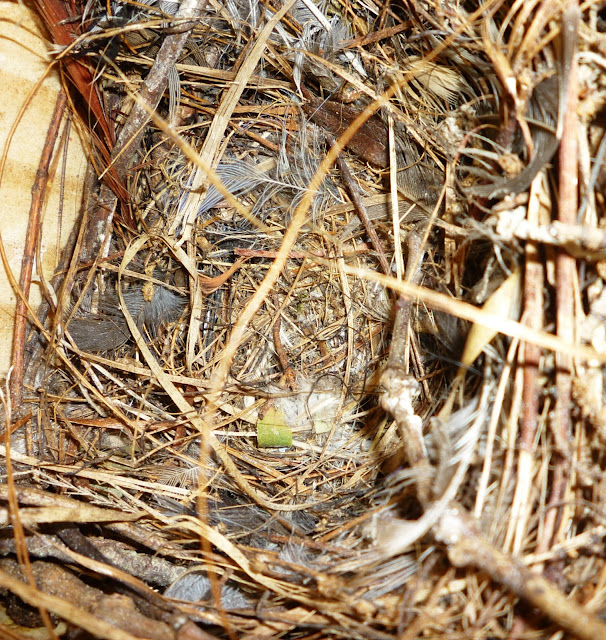June 21, 2013
This post is for Layla.
She is 6 years old today.
Happy Birthday, Layla!
This post is for Layla.
She is 6 years old today.
Happy Birthday, Layla!
Mr. Rogers, from Mr. Rogers' Neighborhood, used to talk about Troglodytes aedon, the House Wren, on his children's television program. The name Troglodytes means "cave dweller". Wrens typically like to nest in "cavities" like a nest-box, but also lots of other places like hanging flower baskets, barbecue grills, window air conditioners, woodpecker holes, and many other unusual places.
to see info about the character:
http://en.wikipedia.org/wiki/Neighborhood_of_Make-Believe#Regular_puppets
http://en.wikipedia.org/wiki/Neighborhood_of_Make-Believe#Regular_puppets
 |
By early afternoon on June 19th the fourth and fifth wren chicks hatched. They are all piled up on each other so they are difficult to count. |
 |
On their second day, June 20th, it is easy to count four of the nestlings. The fifth one is under the "pile". Their eyes are still unopened. It seems the nest is full of little wings and legs. |
 |
On the morning of their third day, the nestlings are resting comfortably, their eyes still not open. The mother bird fusses at me from a dogwood tree nearby. Later the male sings his bubbly song from a deciduous azalea a little further away. (June 21st) |
http://www.soundboard.com/sb/Wren_bird_Songs_clips
http://www.tnwatchablewildlife.org/soundfiles/09042716030021692.mp3
http://www.allaboutbirds.org/guide/House_Wren/sounds
http://www.tnwatchablewildlife.org/soundfiles/09042716030021692.mp3
http://www.allaboutbirds.org/guide/House_Wren/sounds
Happy Birthday, Layla!
 |
| On the morning of their fourth day you can see the opened ear canal on the baby wren at the lower right (you can just see the edge of its beak just below and to the left of the opening). Can you count all five babies? (June 22nd) |
 |
| Mother wren is fussing with me this morning as I check-in on her babies. |
 |
| On the fifth day the feather sheaths become apparent along their wings. There is something in the nostril of one of the chicks. (June 23rd) |
 |
| Still on their fifth day you can see the backs of two chicks heads and the beaks of the other three. (June 23rd) |
 |
| Here is close-up of a chick with its eyes still unopened and its beak partially open on the fifth day. (June 23rd) |
 |
| On the sixth day the feather sheaths along the wings extend. Feathers are made of keratin (sounds like "carrot ten"), and is the same material from which our hair, fingernails and toenails are made. (June 24th) |
 |
| On the seventh morning, you can see the brown feather tips beginning to emerge from the feather sheaths. (June 25th) |
 |
| In this close-up on day eight you can see the brown feather tips extending further from the feather sheaths. (June 26th) |
 |
| Again on the eighth day you can see a couple chicks with their eyes open. (June 26th) |
 |
| On the ninth day I found one chick pulled to the front of the nest near the entrance hole. It was obviously not alive and a few flies had already gathered. The feathers continue to develop on the other four nestlings. (June 27th) |
 |
| In this picture you can see that the little chick's feathers had not developed as much as its siblings. I am not sure of course, but I suspect this was a weak one who was not able to get its head up to be fed as frequently as the others. I removed its body from the nest to protect the others from its decaying body. I buried it under a blooming Rhododendron bush about 50 feet away from the nest. (June 27th) |
 |
| Soon after I buried the little one, a bumblebee that was gathering nectar from the Rhododendron bloom flew off and gave us this in flight picture. (June 27th) |
 |
| It's day ten already and these little birds have really grown. The parent birds have been busy all day feeding them. I put out live meal worms on the sidewalk nearby. The parent bird came and picked up a worm one at a time and banged it on the sidewalk before taking it to the nestlings. (June 28th) |
 |
| The nest is filling up with baby birds on day eleven. You can see some of the striping along the wings starting to appear as the feathers push further out of their sheaths. (June 29th) |
 |
| This is another picture from day eleven. (June 29th) |
 |
| Early on day twelve the feather sheaths are hard to spot as the wing feathers continue to develop. I have read that the sheaths will break off in bits or will be removed by the bird as the feather finishes growing to full length. (June 30th) |
 |
| Still early on day twelve (the last day I should be doing this) I slipped one of the little wrens out of the nest-box for less than a minute. After day twelve there is a risk that the nestling might want to get back out of the nest before it is fully matured and ready to fly. This little bird was very warm to my palm and clutched my finger with one of its feet. It went eagerly back into the nest-box. (June 30th) |
 |
| A second picture a few seconds later shows the dark banding across the wing and you can see short sections of the feather sheaths midway along the wing. (June 30th) |
 |
| On day 13 all eyes are looking back at the camera. The parents are staying busy flying bugs to the nest. (July 1st) |
 |
| We are getting very leggy in here! (July 1st) |
 |
| On day 14 the nest is getting more and more crowded. The black banding on their wings is getting very prominent. (July 2nd) |
 |
| On day 15 the tail feathers look to be getting longer. (July 3rd) |
 |
| On day sixteen both parents have been flying to the nest-box non-stop as they feed these hungry nestlings. We put out a handful of live mealworms so that there would be plenty of food available. They look so much like their parents now. It won't be long till they fly from the nest. (July 4th - Independence Day) |
 |
| Early in the morning of day sixteen, two of the babies have fledged. Their two nest mates won't wait much longer. (July 5th before 7 a.m.) |
 |
| On the morning of day seventeen, the nest is empty. Four of the five baby birds have successfully flown from the nest. The parents keep them hidden in the trees and bushes toward the back of the yard and continue to feed them. (July 6th) |
On the morning of the eighteenth day, I heard the male parent singing his bubbly happy sounding song. Not long later I saw him and the female going in and out of another nest-box about 50 feet away from where they had just raised these four babies. I checked the nest-box early in the afternoon and found the foundation of twigs and sticks. These two birds are contemplating nesting again while they tend to the youngsters who left the nest in the past two days. These are busy, busy House Wrens!
 |
| In the middle of a hodge-podge of twigs is a fuzzy white ball. This is a spider egg-case When the baby spiders hatch out they will eat any insect parasites in the nest that might otherwise suck on the baby wrens' blood. It is a way to help keep the babies healthy. |
- As with other bird species, blood-sucking nest parasites can infest a nest and be a problem for the developing nestlings. Some House Wrens have been found to put the egg cases of predatory spiders into the nest material. In a recent laboratory study, when the spiders hatched they fed on the nest parasites and likely improved the health of the nestlings. from http://www.tnwatchablewildlife.org/woodworkingforwildlifedetails.cfm?uid=12102009471782005








Get instant access to 16,000 woodworking plans.
ReplyDeleteTeds Woodworking has over 16,000 woodworking plans with STEP-BY-STEP instructions, pictures and diagrams to make all of the projects very easy...